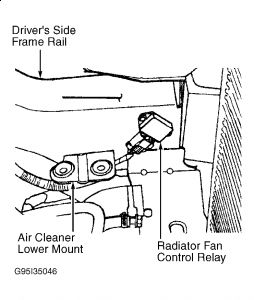Engine Coolant Temperature (ECT) sensor delivers input signal to Powertrain Control Module (PCM) to indicate engine coolant temperature. PCM uses input signal for controlling air/fuel ratio, ignition system, idle speed and cooling fan operation. Engine coolant temperature sensor is located on or near the thermostat housing and contains a Black/Light Blue wire and a Tan/Black wire in the connector.
Radiator Fan Control Relay
Radiator fan control relay may be referred to as radiator fan control module. Relay is a solid state relay. Relay controls operation of radiator cooling fans. Radiator cooling fans will operate at variable speeds depending on engine coolant temperature and the A/C system pressure. PCM pulses ground (control) circuit to signal requested fan speed. Radiator fan control relay is located near driver's side frame rail and air cleaner lower mount. See Fig.
Radiator fan control relay receives constant battery voltage from fuse No. 24 (40-amp) in power distribution center. The Powertrain Control Module (PCM) controls the ground circuit for radiator fan control relay by using a pulsed (time on) ground. This pulsed ground is known as Pulse Width Modulated (PWM) ground. The PWM ground causes radiator cooling fan relay to produces a proportional output voltage for operating radiator cooling fans at different speeds.
Radiator cooling fans operate at high speed when engine coolant temperature is approximately 225 °F (107 °C) and then reduces to low speed when engine coolant temperature decreases to approximately 214 °F (101 °C). Radiator cooling fans will turn off when engine coolant temperature decreases to approximately 199 °F (93 °C). Also, when the A/C pressure sensor closes at approximately 275-295 psi (19.3-20.7 kg/cm2 ), radiator cooling fans operate at high speed. When A/C pressure decreases approximately 40 psi (2.3 kg/cm2 ), A/C pressure sensor opens and radiator cooling fans operate at low speed

SPONSORED LINKS
Sunday, May 10th, 2009 AT 7:26 PM
